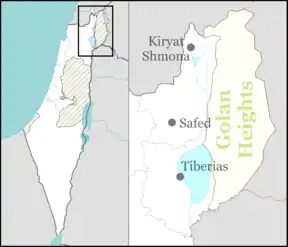Margaliot
Margaliot (Hebrew: מַרְגָּלִיּוֹת; Arabic: هونين) is a moshav in northern Israel. Located along the border with Lebanon in the Upper Galilee, near the town of Kiryat Shmona, it falls under the jurisdiction of Mevo'ot HaHermon Regional Council. In 2021 it had a population of 416,[1] most of them Mizrahi Jews.
Margaliot
מַרְגָּלִיּוֹת هونين | |
|---|---|
 View of Margaliot | |
 Margaliot | |
| Coordinates: 33°12′52″N 35°32′41″E | |
| Country | Israel |
| District | Northern |
| Council | Mevo'ot HaHermon |
| Affiliation | Moshavim Movement |
| Founded | 1951 |
| Founded by | Jewish immigrants from Yemen and Iraq. |
| Population (2021)[1] | 416 |
Name
The moshav was named after agronomist Haim Margaliot-Kalvarisky, a principal director of the Jewish Colonization Association who was appointed by Baron Edmond de Rothschild to supervise the work of Jewish colonies in Galilee in the early twentieth century.[2]
History
A settlement existed at the site in the Iron Age I (1200-1000 BCE), and again from the Persian period (586-332 BCE) until the latter part of the Byzantine period (5th-6th centuries CE).[3]

The Crusader castle of Chastel Neuf (in medieval French) or Castellum Novum (in Latin), lit. "New Castle", was built around 1106-1107 immediately north of the current moshav.[3] Refortified by Mamluk sultan Baibars in 1266, the castle was completely rebuilt in the 18th century[4] by Zahir al-Umar, who ruled the Galilee in the 18th century (1730s–1775). Remains of the castle, covering an area of 9 dunams, include a rock-hewn Crusader moat, cisterns, and a vaulted gatehouse and other wall remains from the 18th century.[3][4]
The moshav was built in part on the grounds of the former Shiite Arab Palestinian village of Hunin, established in the 18th century and depopulated during the 1948 war.[3]
Margaliot was established in 1951, by Jewish immigrants from Yemen and Iraq, on the site of the depopulated Arab village.[3]
During the 2006 Lebanon War, 230 residents of Margaliot were evacuated to the Neve Hadassah youth village near Netanya due to Katyusha rocket fire from Lebanon.[5]
In the 2023 conflict between Hamas and Israel, Hezbollah targeted northern Israeli border communities, forcing evacuations, including in Margaliot.[6] On October 21, two foreign workers from Thailand were wounded by shrapnel in an attack by Hezbollah in the Margaliot area.[7]
Notable residents
- Yossi Sarid (1940–2015), politician and news commentator
References
- "Regional Statistics". Israel Central Bureau of Statistics. Retrieved 22 February 2023.
- "Dr. Chaim Kalvarisky Buried in Palestine; Was Chief Exponent of Arab-Jewish Unity". Jewish Telegraphic Agency. 21 January 1947. Retrieved 1 March 2021.
- Freundlich, Amir (September 2007). "Hunin Fortress: Preliminary plan for conservation and development". Conservation Department: Heritage Preservation in Israel. Israel Antiquities Authority. Retrieved 19 April 2019.
- Pringle, D. (1997). Qal'at Hunin (No. 164). p. 79. ISBN 9780521460101. Retrieved 28 February 2021.
{{cite book}}:|work=ignored (help) - Azoulay, Yuval (July 18, 2006). "Moshav Margaliot relocates to Netanya". Haaretz. Retrieved April 19, 2019.
- Fabian, Emanuel. "IDF to evacuate civilians from 28 communities along Lebanese border amid attacks". www.timesofisrael.com. Retrieved 2023-10-22.
- Fabian, Emanuel. "IDF drones hit Hezbollah terror squads amid uptick in attacks; soldier seriously hurt". www.timesofisrael.com. Retrieved 2023-10-22.